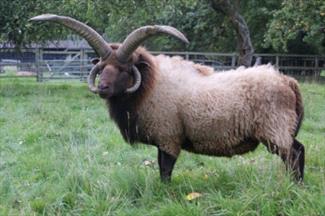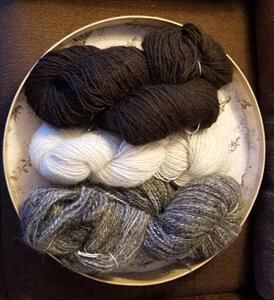Manx Loaghton sheep

A Manx Loaghton sheep. Photo courtesy of the UK's National Sheep Association.
Knitters love sheep for so many reasons. Sheep are perfectly suited for jokes, notably puns.
Q: Why are sheep bad drivers?
A: Too many illegal ewe turns.
Q: What kind of car is best for a sheep?
A: A Lamborghini.
Plus, they provide great material for our favorite pastime, and are adorable if a wee bit odiferous.
Contrary to what is thought of our little darlings by those not in the know, sheep are not stupid. As prey animals, they have a magnificent flocking instinct that keeps them together. That instinct to huddle together is their only protection while they wander places where coyotes, domestic dogs, mountain lions, bears, bobcats, eagles and foxes enjoy dining on them. They are smart enough to circle the wagons when predators are nearby, and they just keep following the sheep in front; who gets to be in front and why is a mystery to me. It’s the food chain in life, and the predators are not on the lamb afterwards.
They are so social that being alone creates enormous stress, even panic.
“Sheep display an intensely gregarious social instinct that allows them to bond closely to other sheep and preferentially to related flock members,” says veterinary behaviorist Dr. Gary Landsberg.
They have deep, lifelong relationsheeps and large family reunions.
Instinct is a lifesaver, so the slang definition of sheep drives me crazy. Urban Dictionary says a sheep is:
Someone who mindlessly follows and emulates anything and everything in the name of fame/recognition. A waste of flesh and brain cells.
Pffft. There’s a difference between mindlessness and instinct. Instinct saves lives. Mindlessness loses your dinner and cookies to your dog.
Have you ever seen a group of sixth graders? They flock together by instinct too, and are far noisier than an equivalent number of sheep. Everyone should experience being followed around by a few sheep; it’s hilarious (and you thought you never went to the bathroom alone with a dog). It’s like having a fleecy entourage with bits of hay stuck to the edges.
Knitters, spinners, and other hand crafters are genuinely fond of sheep because they produce wool, one of the world's most ewesful renewable resources (kind of like dog poop and cat barf, but easier to work with). Wool is heaven for us, lots and lots of fluffy wool in different dyed colors, widths, blends, and warmth that can become anything from long winter coats to christening gowns to piles of sweaters, scarves and mittens. Shopping for wool is a passionate enterprise and not for sheepskates. We talk about what projects we could someday make with it, what we can realistically make with it while working full time, and how we wish we could have four stomachs like they do (dessert pouch, anyone?).
Doing handwork that produces something useful, like a sweater, rug or hat, is seriously calming. I once grabbed some yarn and needles before heading out to the emergency room and knitted until the doctor got there. Need some relaxation in your life, a little anxiety reduction? Start playing with wool and handcrafts. Sure, there’s a learning curve involved, as there is with anything of value. My language was so bad when I was learning to knit that I needed some censorsheep. But once you get into the rhythm, you’ll be content enough to chew a cud, even spiritually calm. It’ll help you sleep better than counting sheep at night.
Safety tip #1: Do not ask knitters about the financial net worth of hidden yarn stores in our basements or risk becoming a black sheep; some of us could fund our retirement by selling that stash, not that we’d ever give it up. Some day the perfect project for it will come along. The point of having a stash is to not have to wait until the yarn store opens in 9 hours.
Wool is a natural insulator that absorbs up to 30 percent of its own weight in moisture before it feels wet (it may, or more likely will, smell like a wet dog after a bath). That’s why traditional Irish fisherman sweaters are made from wool; the fancy pattern makes it thicker and warmer. Its breathability allows you to sweat like a marathoner and still let it evaporate, unlike polyester, which just clogs your sweat into the seams. Wool can be made in a tropical weight that is wonderful in warm weather. Wool is nature’s own climate control as it can keep you warm when it’s cold and cool when it’s warm; it’s perfect for folks working outside in the cold, sitting at a desk freezing off their behinds, or wearing shearling-lined boots in the height of summer in Australia.
Safety tip #2: Carded wool yarns are pretty scratchy on the skin, so unless you’re using one of the combed types of wool, such as merino, you’ll likely want some kind of liner in-between your skin and the wool. Try it on before you decide if you can wear it next to your skin.
Yarn spun with dog hair

While mixed with wool, the black yarn is from a Newfoundland, the white yarn is from a Great Pyrenees, and the gray is a mixture of the two. The dogs lived together and have both passed on. Photo by VIN.
Of course, sheep are not the only mammals whose fleece we use. We make yarn from alpacas, cashmere goats, angora rabbits, llamas, bison, and so on, but sheep’s wool is baa far the most common.
Wool can certainly be spun together with dog or cat hair. Many folks with long-haired dogs save the clean hair from the groomer, and then have it spun into yarn so that they can have a hand-made scarf or gloves made of it. Dog hair usually has to be blended with wool because dog hairs are shorter than sheep's, and cat’s hair is so fine and short and you get so little of it that it is used for something small, like a collar or edging.
Safety tip #3: Unlike acrylic yarn (manmade and inexpensive), wool burns quite slowly. If a fire breaks out, wool will not burn and fuse to your skin quickly the way acrylic will. If you want to differentiate between wool and high-end acrylic, light a match to the yarn to see if it burns. Acrylic is not as warm in the winter, but it is easier to care for because you can throw it into the washer and dryer, but many of today's washing machines have a wool cycle. Just don't put it in the dryer or your miniature poodle can have a new felted coat.
Sheep are an ancient species so there are hundreds of breeds. Some look sweet and adorable, and some don’t: I’m talking to you, Manx Loaghton, and your three to six horns. What an overachiever! He’s like the father sheep of ancient breeds. (Sorry, that was a sheep shot.) Check out the numerous breeds from the U.K.’s National Sheep Association. It’s full of wondrous photos of rare breeds and sheepish grins.
Perhaps now you will consider learning a handcraft involving wool (these classes do not usually have scholarsheeps, unfortunately). Handwork is productive and good for relaxation, and unlike cleaning the barn, you can wear your effort. If you do want to give it a try, I hope all goes wool.
2 Comments
Anne Elizabeth Katherman
January 25, 2019
Lisa Marie McKay
January 22, 2019